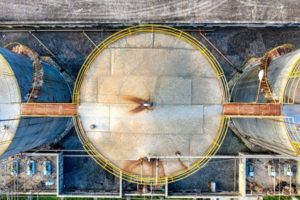In February 2016, a worldwide chemical company was looking for a solution to protect a bund at a chemical plant in Scotland.
The client had a 450 tonne, steel methanol tank currently housed within an open-air, concrete bund. The bund walls and floor were porous and unlike adjacent bunds onsite, it did not hold rainwater. To ensure that the bund was compliant with the Scottish Environment Protection Agency (SEPA), the client wanted to put in place a protective chemical containment coating that was liquid-tight to protect against the environmental release of methanol if the tank failed.

Tight timeframe
The total bund surface area that was to be coated was around 460m2, which included a 0.5m vertical band around the concrete plinth, walls, and a 1m band up onto the concrete plinth. Previous attempts to repair cracks and fillets around the base of the plinth and surrounding walls had resulted in failures, leaving several areas of the bund vulnerable. As well as needing to restore these, a 25m, linear, mastic, expansion joint also needed to be replaced. To cope with the level of concrete movement, the asset owner required a protective coating which could move in sympathy with the large concrete pad and cope with stresses if any further cracks developed. A 0.4m drainage channel, previously coated with Belzona 3121 (MR7), a 2-part polymer composite, was removed during preparation.
Every day, the plant receives three truckloads of methanol, which takes up to one hour to unload completely. During this time, onsite work must stand down, therefore any solution had to be applied within this timeframe.
A combination of concrete cracking and chemical-resistant solutions
The client was offered a combination of Belzona solutions to address each problem within the bund, providing a complete repair and protection solution.
Before the application, the area was cleaned using a combination of detergent and antifungal washing, alongside high-pressure water to remove any contamination and aggressive chemicals. Blasting wasn’t permitted due to the tank containing methanol, so any loose concrete was removed to ensure a firm substrate. The surface was then abraded to expose the aggregate by mechanical scarification.
Belzona 4911 (Magma TX Conditioner) was used on all the surfaces where Belzona repair and protection solutions were to be applied. Once the surfaces had dried, any cracks in the substrate were filled with Belzona 4131 (Magma screed). This material was also used to create fillets to reinforce the joints between the walls, floors and tank base where required. The chemical-resistant Belzona 4361 was chosen to coat the entire bund area, including walls, concrete plinths and drainage channel due to its excellent chemical resistance against methanol, flexibility and good adhesion, facilitating long-term sealing between the wall and the floor.
The second coat was directly applied within 24 hours of the first. Belzona 9211 (Supergrip Aggregate) was sprinkled on top of the curing Belzona 4361 to create a 1m wide non-slip walkway (80m linear) to key areas within the bund where regular access is required. This application improves the non-slip and positive-drive application. In addition, the 25m2 expansion joint was removed, cleaned, masked off and conditioned with Belzona 4911. A foam backing rod was subsequently inserted before Belzona 4521 (Magma-Flex Fluid) was then mixed and poured into the void.
A long-lasting barrier
Appropriate secondary containment has long been a legal requirement in many countries, particularly around tanks, storage vessels and other plant equipment containing hazardous liquids. Regulations (such as the Control of Pollution Regulations 2001 in England) are enacted to establish preventative measures. By not complying with these regulations, companies risk being heavily fined, sometimes to the extent of incurring criminal proceedings.
However, in this case, the 2-part epoxy coating Belzona 4361 helped to comply with the legislation relating to effective bund protection. As a result, its successful installation has helped the chemical plant to ensure a long-lasting barrier to unwanted chemicals leaching into the environment.
If this article has piqued your interest and you would like to read more about 2-part epoxy coatings and their use within the coatings industry, why not sign up for our quarterly publication? Full of the latest news and industry latest articles relating to the marine and protective coatings industry. Get your copy today, it’s free!
